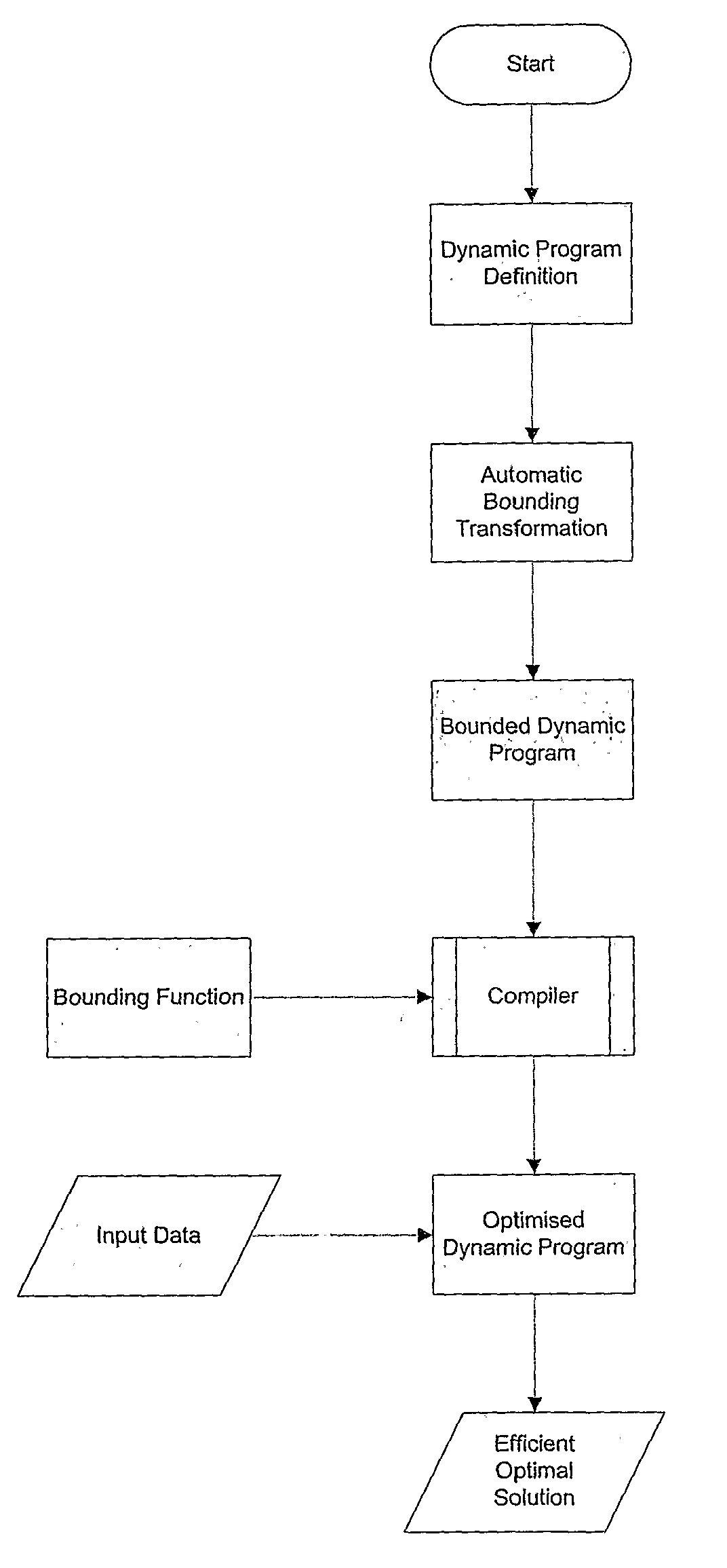Automating dynamic programs
a dynamic program and programming technology, applied in the direction of program control, complex mathematical operations, instruments, etc., can solve the problems of combinatorial optimisation problems, and achieve the effects of improving pruning efficacy, improving speed, and avoiding the extension of the number of calls to be mad
- Summary
- Abstract
- Description
- Claims
- Application Information
AI Technical Summary
Benefits of technology
Problems solved by technology
Method used
Image
Examples
example 3
[0052]Consider the knapsack program defined in Example 1. The result of the local bounding transformation (omitting the memoization wrapper and after inlining the definition of lbedk(i−1,w−w2, x1−pi)) is:
k(i, w) = if i = 0 then 0else if w i then k(i − 1,w)else let x1 = k(i − 1,w) inmax( x1,let x2 = let x3 = uk(i − 1,w − wi) inif x3 ≦ x1 − pi then x3else k(i − 1,w − wi)in x2 + pi)
[0053]It can be seen that if the upper bound on the second call k(i−1,w−wi) is not good enough to increase the max then the recursive call will not be made. The resulting code could be improved further, for example it is possible to substitute for x2 since it occurs only once. Also if x2 takes the value uk(i−1,w−wi) then it is guaranteed that it will not create a maximum, but improving this is more difficult and the overhead is low.
[0054]The local bounding technique ensures that before any call to dp(ō) if there is a known lower bound, then a check is made whether the upper bound can surpass the lower bound....
example 4
[0059]The local ordered version of knapsack, where the memoization wrapper and inlined calls to lbedk are omitted, is:
k(i,w) = if i = 0 then 0else if w i then k(i − 1,w)else let x1 = uk(i − 1,w) inlet x2 = uk(i − 1,w − wi) + pi inif x1 ≧ x2then let x3 = k(i − 1,w) inmax( x3,let x4 = let x5 = uk(i − 1,w − w1) inif x5 ≦ x1 − pi then x5else k(i − 1,w − wi)in x4 + pi)else let x6 = k(i − 1,w − wi) + pi inmax( x6,let x7 = uk(i − 1,w) inif x7 ≦ x6 then x7else k(i − 1,w))
[0060]One can begin to see why a programmer may want these transformations automated, given the relative size of this code compared to the starting code of Example 1. It is noted that this code can be improved, for example by recognizing that x7=x1.
[0061]As defined, the ordering is only applied to a top-most min or max expression. An ordered version of lbed can be defined which also orders any sub-expressions. However, since the ordering code adds significant overhead, it is likely not desired at every level of the expressi...
example 5
[0069]The argument bounded version of knapsack is:
k(i,w,l) =let p = getdp(ō)in if optimal(p) then value(p)else let u = if known(p) then bound(p) else upperk(i,w)in if u ≦ l then uelse let r = if i = 0 then 0else if w i then k(i − 1,w,l)else let x1 = k(i − 1,w,l) inmax( x1,k(i − 1,w − wi,max(l,x1) − pi) + pi)in if r > l then setdp(ō,r) elsebsetdp(ō,r)
[0070]Note that, as opposed to the local transformation, in this example only one lookup of the memo table per function call is required.
[0071]One extra requirement of the argument bounded version is that the initial call must have a suitable initial bound. If maximizing, a lower bound is required, this being the opposite bound to the function we require for optimizing transformation. One suitable approach is to use a heuristic solution to the problem to get a good bound.
[0072]We straightforwardly combine the argument bounding approach with ordering of sub-expressions using the ordered rewriting for lbed of Section 4.2.
[0073]A result ana...
PUM
 Login to View More
Login to View More Abstract
Description
Claims
Application Information
 Login to View More
Login to View More - R&D
- Intellectual Property
- Life Sciences
- Materials
- Tech Scout
- Unparalleled Data Quality
- Higher Quality Content
- 60% Fewer Hallucinations
Browse by: Latest US Patents, China's latest patents, Technical Efficacy Thesaurus, Application Domain, Technology Topic, Popular Technical Reports.
© 2025 PatSnap. All rights reserved.Legal|Privacy policy|Modern Slavery Act Transparency Statement|Sitemap|About US| Contact US: help@patsnap.com



